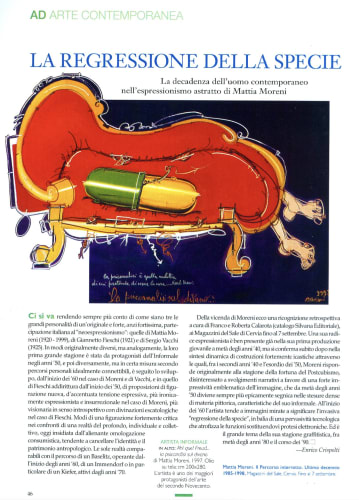It is becoming increasingly clear that there are three major figures behind a truly original and powerful—indeed, extraordinarily powerful—Italian contribution to "Neo-Expressionism": those of Mattia Moreni (1920–1999), Giannetto Fieschi (1921), and Sergio Vacchi (1925). In originally different but analogous ways, their first major period was as protagonists of the Informale movement in the 1950s. Then, albeit along different yet ideally connected paths, came the development—beginning in the early 1960s for Moreni and Vacchi, and as early as the early 1950s for Fieschi—of a new kind of figuration. This new direction was marked by heightened expressive tension: more ironically expressionist and insurrectional in the case of Moreni, more visionary and introspective with eschatological overtones in the case of Fieschi.
These are modes of figuration that are deeply critical of a reality rooted in the depths of both the individual and the collective—a reality today threatened by the alienating uniformity of consumerism, which tends to erase identity and anthropological heritage. Their work is comparable only to the path of Georg Baselitz, active since the early 1960s, or of Jörg Immendorff, and especially Anselm Kiefer, already active in the 1970s.
A retrospective overview of Moreni's work—curated by Franco and Roberta Calarota (Silvana Editoriale catalogue)—is currently on display at the Magazzini del Sale in Cervia, open until September 7. An expressionist root is already clearly present in his early youthful production from the mid-1940s and is soon confirmed in the dynamic synthesis of powerfully iconic constructions. Between the late 1940s and his debut in the 1950s, Moreni offered an original response to the successful Post-Cubist period, uninterested in narrative developments in favor of a strong emblematic impact of the image. From the mid-1950s, his work became increasingly epic and sign-like in its application of thick pictorial material, characteristic of his Informale phase.
In the early 1960s, the artist shifted toward images designed to signify the invasive “regression of the species,” caught in the grip of a technological pervasiveness that atrophies human functions and replaces them with electronic prostheses. This became the central theme of his graffitist period, between the mid-1980s and 1990s.
Mattia Moreni. The Interrupted Path. Final Decade 1985–1998,
Magazzini del Sale, Cervia. Until September 7

Ah! quel Freud.. la psicanalisi sul divano (Ah! That Freud... psychoanalysis on the couch), Mattia Moreni, 1997, Oil on canvas: 200 x 280 cm. The artist is one of the major figures of postwar Italian art.

